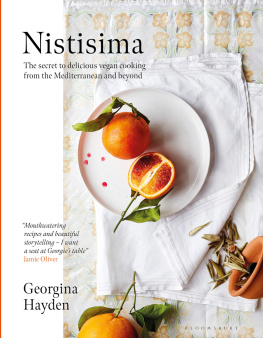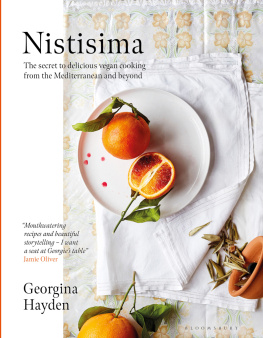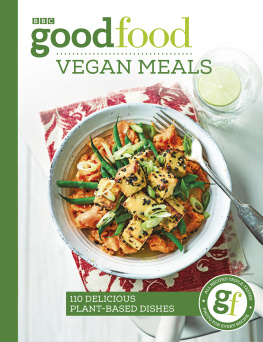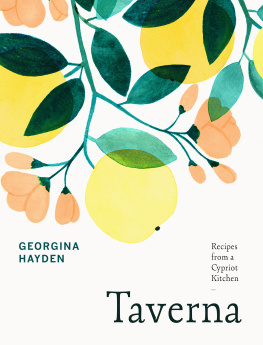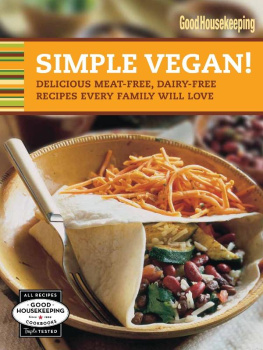Mum and Dad,
Thank you for everything you do for us. There is no way I could have written this book (or written or cooked anything, for that matter) without your constant love and support.
x

BLOOMSBURY PUBLISHING
Bloomsbury Publishing Plc
50 Bedford Square, London WC1B 3DP, UK
29 Earlsfort Terrace, Dublin 2, Ireland
This electronic edition published in 2022 by Bloomsbury Publishing Plc
BLOOMSBURY, BLOOMSBURY PUBLISHING and the Diana logo are trademarks of Bloomsbury Publishing Plc
First published in Great Britain 2022
Text Georgina Hayden, 2022
Photographs Kristin Perers, 2022
Georgina Hayden and Kristin Perers have asserted their right under the Copyright, Designs and Patents Act, 1988, to be identified as author and photographer, respectively, of this work.
For legal purposes the Acknowledgements constitute an extension of this copyright page.
All rights reserved
You may not copy, distribute, transmit, reproduce or otherwise make available this publication (or any part of it) in any form, or by any means (including without limitation electronic, digital, optical, mechanical, photocopying, printing, recording or otherwise), without the prior written permission of the publisher. Any person who does any unauthorised act in relation to this publication may be liable to criminal prosecution and civil claims for damages.
Bloomsbury Publishing Plc does not have any control over, or responsibility for, any third-party websites referred to or in this book. All internet addresses given in this book were correct at the time of going to press. The author and publisher regret any inconvenience caused if addresses have changed or sites have ceased to exist, but can accept no responsibility for any such changes.
A catalogue record for this book is available from the British Library.
ISBN: 978-1-5266-3068-1 (HB)
ISBN: 978-1-5266-3069-8 (eBook)
ISBN: 978-1-5266-5702-2 (ePDF)
Project Editor: Holly ONeill
Designer: Anna Green at Siulen Design
Photographer: Kristin Perers
Food Stylist: Joss Herd
Prop Stylist: Tabitha Hawkins
Indexer: Vanessa Bird
Bloomsbury Publishing Plc makes every effort to ensure that the papers used in the manufacture of our books are natural, recyclable products made from wood grown in well-managed forests. Our manufacturing processes conform to the environmental regulations of the country of origin.
To find out more about our authors and their books please visit www.bloomsbury.com where you will find extracts, author interviews and details of forthcoming events, and to be the first to hear about latest releases and special offers, sign up for our newsletters.
Eat to live, not live to eat
SOCRATES (469399 BCE)


Contents
The idea to write Nistisima began while I was researching Taverna, my previous book which is centred around Cyprus, my family and all of our inherited recipes. When I was recording the stories Id been told, the recipes that were shared, the foods I have been brought up eating, I realised how many of them revolve around the Greek Orthodox calendar. How we ate was especially governed by the days and weeks during the year with fasting rules: no dairy, no meat or fish on certain days; no olive oil or wine on others. Growing up, I never questioned why we have countless cake recipes that are oil-based and contain no eggs, or that we drank almond milk, long before it became trendy in caf culture, but now I understand that this came about from necessity.

The Greek word nistisima translates as Lenten, or fasting, foods. These are foods that, on the whole, do not contain any animal products and adhere to the Orthodox churchs fasting rules. It is the plant-based recipes and traditions that I am exploring in this book. Those of Orthodox faith can spend up to 200 days a year fasting or eating in this restricted way, and historically our recipes and diets in Greece and Cyprus reflect this (despite the kebabs and grills that you may be familiar with). It is so ingrained in our everyday life that it isnt uncommon to find sections of the local bakery or deli dedicated to plant-based foods. While there isnt a huge appreciation for veganism, or even vegetarianism, in Cyprus, if you were to explain your diet as nistisimo people would know exactly what you meant.
It is important to note that this is not a religious or diet book. I am not here to tell you how to pray, how to live your life or even how to eat this book is for everyone. Perhaps you happen to be Orthodox and are looking for recipes to try while fasting, or maybe you are adopting a plant-based diet and need inspiration for meals. It could be that you see the recipes and stories of your relatives here, your roots, and you want to feel that connection with home. Or you simply want to eat more vegetables. Why and how you use this book is up to you.
Fasting is a historic practice among many communities and religions, each with their own rules, whether it is cutting out certain food groups, or not eating at certain times. And, as well as religion, there is nothing new about abstaining from or eliminating certain foods. It is said that fasting has been used therapeutically since at least the year 5BCE, when Hippocrates prescribed to some patients that they abstain from food and drink. And of course, fasting has come under the spotlight in recent years, as diets such as intermittent fasting have risen dramatically in popularity. So in a time when many of us are now looking at our own diets and ways to change our eating (whether it be for health, the environment or frugality), these recipes and traditions feel more relevant than ever.
Why
The purpose of fasting for Lent is to give something up as a form of self-discipline, to be able to reflect and prepare before a large religious celebration. By observing forty days of Lent those of Christian faith aim to replicate Jesuss withdrawal into the wilderness. For others, whether of faith or not, abstinence and fasting can be purely a way of cutting back, taking stock and reassessing.
The quote at the beginning of the introduction is attributed to the Greek philosopher Socrates (coincidentally, my maiden-namesake): eat to live, not live to eat. I used to shudder at the thought of being someone who ate to live, rather than lived to eat. I was interpreting his quote on a basic level, describing a person who purely ate to function. However, I believe Socrates meant something deeper: food should be nourishing; energy to power our lives. Something I noticed from recipe-testing this book is that the recipes are full of flavour and (as youll see I often note) quietly addictive, but I never felt sluggish after eating and the desire to over-indulge just wasnt there. Im not trying to sell you on veganism, and meat still has a place in my kitchen and on my table; however, a prolonged period of eating this way did leave me feeling lighter, for want of a better word.

